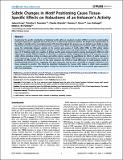Por favor, use este identificador para citar o enlazar a este item:
http://hdl.handle.net/10261/129459COMPARTIR / EXPORTAR:
 SHARE SHARE
 CORE
BASE CORE
BASE
|
|
| Visualizar otros formatos: MARC | Dublin Core | RDF | ORE | MODS | METS | DIDL | DATACITE | |

| Título: | Subtle changes in motif positioning cause tissue-specific effects on robustness of an enhancer's activity |
Autor: | Erceg, Jelena; Saunders, Timothy E.; Girardot, Charles; Devos, Damien P. CSIC ORCID; Hufnagel, Lars; Furlong, Eileen E. M. | Fecha de publicación: | 2014 | Editor: | Public Library of Science | Citación: | PLoS Genetics 10(1): e1004060 (2014) | Resumen: | Deciphering the specific contribution of individual motifs within cis-regulatory modules (CRMs) is crucial to understanding how gene expression is regulated and how this process is affected by sequence variation. But despite vast improvements in the ability to identify where transcription factors (TFs) bind throughout the genome, we are limited in our ability to relate information on motif occupancy to function from sequence alone. Here, we engineered 63 synthetic CRMs to systematically assess the relationship between variation in the content and spacing of motifs within CRMs to CRM activity during development using Drosophila transgenic embryos. In over half the cases, very simple elements containing only one or two types of TF binding motifs were capable of driving specific spatio-temporal patterns during development. Different motif organizations provide different degrees of robustness to enhancer activity, ranging from binary on-off responses to more subtle effects including embryo-to-embryo and within-embryo variation. By quantifying the effects of subtle changes in motif organization, we were able to model biophysical rules that explain CRM behavior and may contribute to the spatial positioning of CRM activity in vivo. For the same enhancer, the effects of small differences in motif positions varied in developmentally related tissues, suggesting that gene expression may be more susceptible to sequence variation in one tissue compared to another. This result has important implications for human eQTL studies in which many associated mutations are found in cis-regulatory regions, though the mechanism for how they affect tissue-specific gene expression is often not understood. | Descripción: | This is an open-access article distributed under the terms of the Creative Commons Attribution License. | Versión del editor: | http://dx.doi.org/10.1371/journal.pgen.1004060 | URI: | http://hdl.handle.net/10261/129459 | DOI: | 10.1371/journal.pgen.1004060 | Identificadores: | doi: 10.1371/journal.pgen.1004060 issn: 1553-7390 e-issn: 1553-7404 |
| Aparece en las colecciones: | (CABD) Artículos |
Ficheros en este ítem:
| Fichero | Descripción | Tamaño | Formato | |
|---|---|---|---|---|
| Subtle Changes.pdf | 10,12 MB | Adobe PDF |  Visualizar/Abrir |
CORE Recommender
PubMed Central
Citations
32
checked on 30-mar-2024
SCOPUSTM
Citations
39
checked on 16-abr-2024
WEB OF SCIENCETM
Citations
41
checked on 28-feb-2024
Page view(s)
222
checked on 18-abr-2024
Download(s)
228
checked on 18-abr-2024

